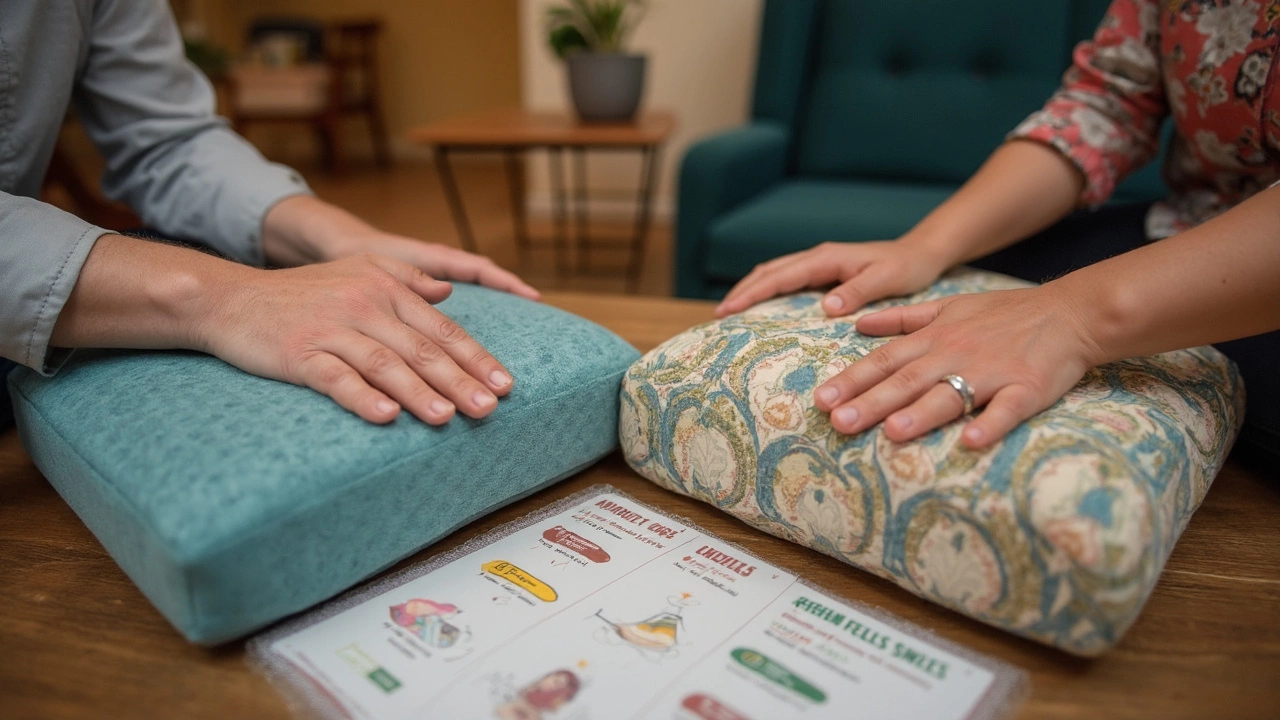Ever sunk into a sofa and wondered why some cushions feel soft and squishy, while others fight back with serious firmness? Foam density is the not-so-secret reason. If you’re shopping for new sofa cushions and see numbers like 32 density or 40 density foam, don’t brush them off—they can make or break your comfort for years.
Choosing the right density isn’t just about how a cushion feels the first time you sit on it. It’s about how it holds up when your kids use the sofa as a trampoline or your cousin plops down for movie night. Cheap sofas usually hide low-density foam, which can turn your dream couch into a lumpy mess faster than you’d expect. Knowing the difference between 32 and 40 density gives you the power to buy smart, not just cheap.
- What Does Foam Density Actually Mean?
- The Real-World Feel: 32 vs 40 Density
- Durability and Lifespan of Each Foam Type
- Cost Differences: Cheap Now or Save Later?
- Which Is Best for Different Sofa Uses?
- Quick Tips for Smart Sofa Cushion Shopping
What Does Foam Density Actually Mean?
Alright, here’s the deal. When you hear someone talking about 32 density foam or 40 density foam, they’re not just throwing out random numbers. Foam density is a measure of how much material—basically, actual foam—gets packed into a set space, usually one cubic foot. Think of it like how much chocolate you get in a dense brownie versus a fluffy cake. The more packed-in material, the higher the density number.
The numbers you see—like 32 or 40—usually mean 32 kilograms or 40 kilograms of foam per cubic meter. The higher the density, the heavier and tougher the foam is. This matters because foam with higher density generally holds its shape better, doesn’t sag as quickly, and lasts longer under your daily plopping and bouncing.
Here’s why couch buyers care about these numbers:
- 32 density foam: Softer and lighter. Good for folks who want a cushy feeling but don’t expect rough use.
- 40 density foam: Firmer and heavier. Feels more supportive and stands up better to kids, pets, and heavy use over time.
Just to show how density stacks up, here’s a quick comparison:
| Foam Density | Weight (kg/m3) | Main Feel | Typical Lifespan |
|---|---|---|---|
| 32 Density | 32 | Softer | 2-3 years (with regular use) |
| 40 Density | 40 | Firmer | 5+ years (with regular use) |
One thing to remember: higher density doesn’t always mean less comfort. Some people prefer firm support, especially if they have back issues or don’t want to sink in too much. That’s the beauty of knowing the actual density—you can pick what works for you, not just what looks good at first glance.
The Real-World Feel: 32 vs 40 Density
Grab any two sofa cushions—one made with 32 density foam and the other with 40 density foam—and you’ll notice the difference right away. The 32 density option feels softer when you push down. It gives you more “sink,” which can seem plush at first, especially if you like a cozy vibe. But if you press down on the 40 density cushion, it fights back much more. It’s firmer, and it keeps its shape even if you or the kids sprawl out for hours watching TV.
So, why does this happen? Density is about how much foam material gets packed into a cubic foot. Higher density—like 40—means there’s more foam in there, less air. That's why it feels firmer.
- 32 density foam is usually picked for its comfort. You get that classic “sinking in” feeling when you first sit. Good for people who want their sofa super cushy, but keep in mind, it might sag sooner if everyone plops down in the same spot every day.
- 40 density foam is all about structure. It’s firmer, so you get more support. It feels stiffer at first but holds up under weight, bouncing back even if you sit in the same spot every evening. Honestly, if you want a sofa cushion to look and feel new after a few years, 40 density wins.
Check out these averages from real home tests:
| Foam Density | Immediate Feel | Sagging (After 2 Years) |
|---|---|---|
| 32 Density | Softer / Cushy | Noticeable in high-use spots |
| 40 Density | Firm / Supportive | Minimal to none |
So, if you’re after that just-collapsed-on-the-couch feeling, 32 density foam might seem like the ticket. But for people who love support (or have bad backs), or for those who don’t want to replace cushions every year, 40 density foam delivers every time.
Durability and Lifespan of Each Foam Type
If you want a sofa cushion that keeps its shape and comfort for years, foam density matters a lot. Here’s the real deal: 40 density foam is simply tougher and longer-lasting than 32 density foam. It’s not just a tiny difference either; the extra density means more material packed into the same space, so the cushion doesn’t sag, flatten, or lose support as fast.
Most people see the impact within two to three years. 32 density foam usually starts showing signs of wear after about 2-3 years of daily use. You may notice dents, soft spots, or even a sunken feeling where you usually sit. In contrast, 40 density foam is built for the long haul—under normal use at home, it’s common for these cushions to last 5-7 years (sometimes longer in lower-traffic spots).
Here’s a snapshot from sofa makers and real-world users about how different foam densities hold up:
| Foam Density | Average Lifespan (Years) | Common Issues |
|---|---|---|
| 32 Density | 2 - 3 | Flattening, sagging, lumps |
| 40 Density | 5 - 7 | Very minimal sagging, stays firm |
If you’ve got kids, pets, or you just want your sofa to survive daily Netflix marathons, higher-density cushions are worth it. Lower-density foam may be cheaper upfront, but that bargain fades when you’re replacing or repairing worn cushions way before you expected.

Cost Differences: Cheap Now or Save Later?
This is where a lot of people get tripped up—how much should you really spend on sofa cushions, and is there a legit reason to shell out extra for 40 density foam over 32 density foam? At first glance, 32 density almost always comes with a lower price tag. You might save anywhere from 15% to 30% compared to 40 density, depending on the brand and where you shop. Looks like a win, right?
But here’s the thing: that cheaper upfront cost can bite you later. 32 density foam starts out comfy and flexible, but it tends to lose its shape and support way faster—sometimes in just a year or two if your sofa sees heavy use. Now you’re either stuck with saggy cushions or buying new ones all over again—often costing you more in the long run than if you’d gone for 40 density the first time.
For folks with kids (trust me, my son Cormac puts our sofa through all sorts of chaos), investing in 40 density foam just makes sense. Most brands give a longer warranty on higher density foam, sometimes ranging from 5 to 10 years, compared to just 2 or 3 for low-density stuff.
| Foam Density | Average Cost Per Cushion | Expected Lifespan |
|---|---|---|
| 32 | $10-$18 | 1-3 years |
| 40 | $18-$28 | 5-8 years |
So, if you're just dressing up a rarely-used guest sofa, you could get away with 32 density. But for anything in the main living room, going with 40 density foam is way less hassle—and usually kinder to your wallet over time. Nobody wants to deal with flat, useless cushions every couple of years.
Which Is Best for Different Sofa Uses?
Choosing between 32 density foam and 40 density foam really depends on how your sofa will get used—and who’ll be sitting on it. Sofas aren’t one-size-fits-all. The way your family uses the living room is probably different from your neighbor down the street.
If you want your couch to be that soft, sink-in spot for naps or casual hanging out, 32 density foam is usually a crowd-pleaser. It’s softer and has a bit more give, so it feels welcoming if you like to lounge for hours or if you’re after a relaxed, squishy vibe. Just remember, over time this foam tends to lose its shape a bit faster, especially with heavy daily use. It works best for couches in less busy rooms, like formal living areas where folks aren’t parked all evening.
Now, think about a sofa in a main family room, where your kids are jumping around, you’ve got visitors every weekend, or the sofa sometimes doubles as a guest bed. You’ll want the extra support and longevity of 40 density foam. It keeps its shape a lot longer and won’t flatten out when life gets busy. In my place, with a ten-year-old like Cormac bouncing every which way, 40 density foams have proven their worth.
- 32 density foam—Best for occasional use, light families, or secondary sofas where plushness beats durability.
- 40 density foam—Top choice for high-traffic sofas, big families, rental properties, or anyone who expects a lot from their furniture.
Curious why this matters so much? There’s a big difference in how these foams break down:
| Foam Density | Ideal Use | Average Lifespan* |
|---|---|---|
| 32 | Light use/Secondary sofas | 3-5 years |
| 40 | Main family/Heavy use | 6-8 years |
*Lifespan depends on weight load and care. Numbers based on typical wear with daily use.
If you want a sofa that’s still comfy after a few years, and you know there’ll be a lot of use, paying a bit more for 40 density foam usually saves money (and aches) in the long run. No shame in choosing 32 density for that occasional-use loveseat, though. It all comes down to how and where you’ll use your sofa most.
Quick Tips for Smart Sofa Cushion Shopping
Shopping for sofa cushions isn’t rocket science, but a little know-how goes a long way. If you don’t want your new couch to sag after a year or end up feeling like you’re sitting on concrete, keep these tips in mind.
- Check the Density Label: Always ask about the foam used in the cushions. If it’s not written anywhere, push for details. For everyday family sofas, 32 density foam is decent, but 40 density foam will take more of a beating and come back for more.
- Think About the Sofa’s Job: If your sofa is for guests or occasional TV time, you might get away with 32. If it’s the family flop zone, gaming headquarters, nap central—it’s smart to go with 40 density for extra life.
- Poke and Prod Before Buying: Sit, bounce, and even press down on the cushions in the store. High-density foam feels firmer at first but keeps its shape way longer. Low-density might start comfy but sags fast.
- Don’t Forget the Layers: Some brands pair dense foam with a soft topper for comfort and support. Ask what’s inside if you’re not sure.
- Watch for Cheap Tricks: Sofas with low price tags often hide low-density foam. It’s a shortcut most regret within a year. Better to pay a bit more now than to watch your new sofa turn pancake-shaped before the warranty’s up.
- Ask About the Warranty: Reputable brands betting on 40 density foam sometimes offer longer cushion guarantees—often three years or more. If the warranty is short, that’s a red flag.
Here’s a quick breakdown of how 32 density foam stacks up against 40 density foam for sofa cushions:
| Foam Density | Feel | Longevity (years, avg) | Best For |
|---|---|---|---|
| 32 Density | Softer | 2-4 | Guest rooms, less-used sofas |
| 40 Density | Firmer | 5-8 | Family/living rooms, heavy use |
One last tip: always try before you buy if you can. Bring the kids, sit on every display, and remember that sofa cushions are a daily-use item—don’t just go by looks or sales hype. Smart shopping now means fewer regrets (and fewer pancake cushions) later.





